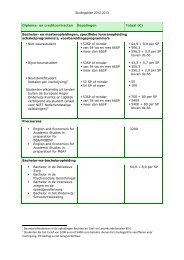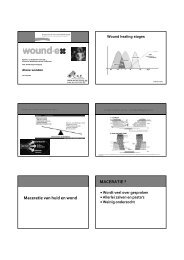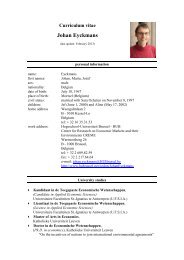Sustainable Development: A Bird's Eye View - MDPI.com
Sustainable Development: A Bird's Eye View - MDPI.com
Sustainable Development: A Bird's Eye View - MDPI.com
- No tags were found...
Create successful ePaper yourself
Turn your PDF publications into a flip-book with our unique Google optimized e-Paper software.
Sustainability 2011, 3 1644It is truly astonishing that while the world’s top scientists warn repeatedly about the catastrophicconsequences of current unsustainable development strategies for billions of people around the globe,political responses still range from negligible to ineffective [24]. But, while the world—mainlywealthy nations and their leadership—negate the consequences of their approval, it cannot be deniedthat global political leadership signed several <strong>com</strong>mitments for sustainable development and—may benot fully aware of their implications—there is no way back [29]. Therefore world politics have notonly the duty but also the moral obligation to present and future generations as well as other life onEarth, to execute the signed <strong>com</strong>mitments and strategies for sustainable development.It would be too reductionist and misleading to evaluate the sustainability transition solely ongovernmental actions because a new <strong>com</strong>plex decentralized international governance system isemerging, that is characterized by a multitude of actors working at various levels [25]. Indeed, thereare also numerous good examples of sustainability efforts by local citizens and <strong>com</strong>munities(i.e., Local Agenda 21 initiatives) that take the sustainability message seriously [19]. However, whilepertinent at the local level, local sustainability initiatives will only make a difference at the global levelif their experience is disseminated and replicated in many more other places around the globe [4].It has already been stated in 1987 in “Our Common Future” [46] and since then repeated a thousandtimes, achieving sustainable development depends essentially on “will” [52]. Particularly, 1) the willof politics which ideally should set the course because it is supposed to serve the <strong>com</strong>mon interest,standing above individual stakeholder interests, and 2) the will of present generations because thedestiny of the planet may well be in their hands [23].“Business as usual” sustainability efforts do not suffice. Instead, to succeed what is needed are farreaching socio-economic and institutional system changes, which fundamentally alter our prevailingway of societal organization and behavior. These changes should truly challenge—instead ofconfirm—fundamental beliefs, values, and assumptions that underpin the prevailing developmentmodel of economic growth and consumerism [24]. And the first essential and logic step should be toget rid of clearly unsustainable practices [52]. Yet, it is still hard to believe that “modern” civilization,with its entire intellectual potential, simply neglects the lessons from history, as some ancientcivilizations ultimately collapsed due to environmental problems [38,39], while other were able to livesustainably for very long time spans [53].4. Fundamental Sustainability PrinciplesIntuitively appealing to the <strong>com</strong>mon sense of mankind [13], sustainable development is likehappiness something that everybody wants and is hard to be “against”. But what sustainabledevelopment precisely en<strong>com</strong>passes varies greatly amongst various stakeholders [45,54] and there iscertainly no such thing as “sustainable development-ism” [17]. There is great arbitrariness in theconcept’s interpretation [9] and there are probably as many views and definitions as people dealingwith the issue, each with their own focus, suiting the particular view of the stakeholderconcerned [17,45] (for an overview [55-57]).Reasons for this variety include: the normative nature of sustainability; the different disciplinaryand professional background of people dealing with the sustainability issue; and, the battle forinfluence [58,59] over the concept’s meaning and the appropriate way to achieve it, given the
Sustainability 2011, 3 1645importance of the concept for future developments of society and visible in variousdiscourse coalitions.Such a divergence is especially likely in highly charged normative concepts such as “democracy”,“freedom”, “justice/equity” and “sustainable development”—sometimes described as the “essentialcontestability” of widely supported social and political concepts. However the range of understandingshardly prevents the application of such contestable concepts in practice [13].But many of the “socalled” sustainability views are in need of conceptual clarification [9,15,18-22] because they are oftenbased on dogmatism and vague assumptions, lacking rational justification and scientific foundation[9]. <strong>Sustainable</strong> development is for example meaningless and even contradictory when interpreted as“sustained change” or “sustained development” (simply a process of change that can last foreverwithout objectives), “sustained growth” (sustaining economic growth and material consumption,contradicting the general recognition that the planet has ultimate environmental limits) or simply“successful development” [14].Instead, sustainable development as a concept possesses a precise and unambiguous meaning.First, and serving as the “sustainability bottom line”, sustainable development aims to meet humanneeds and aspirations, now and in the future, in an equitable way while protecting our environmentwhich we share with other living species on Earth. In other words, ensuring: “Good lives for all peoplein harmony with nature” [40].Second, in support of the “sustainability bottom line”, sustainable development has clear“interpretational limits” and incorporates a more or less stable set of general defining characteristics,which must always be respected, no matter which view one amounts to [14,16]. These characteristicscan be termed “fundamental principles” that “embody” sustainable development [16], and offer ameta-perspective on the concept [9]. They represent the “sustainability play field/arena” or some kindof “<strong>com</strong>mon denominator/ground” that anyone who justifies a line of action with an appeal to thesustainability should respect and take into account [16].There is considerable agreement among sustainability scholars about the concept’s fundamentalprinciples [9-13,16,17]. Based on their work and further grounded in the scholarly literature, wedistinguish four fundamental sustainability principles, also defined as “rules of action towardssustainable development” [16] representing the key changes needed [10,11], which are ofequal importance:• the normativity principle• the equity principle• the integration principle• the dynamism principleFirst, the concept of sustainable development is always socially constructed andnormative [9,12,13,16,45] or subjective—the normativity principle—because ultimately whatsustainability means depends entirely on our views regarding the kind of world we want to live in andwant to leave as a legacy for future generations—our children and grandchildren. <strong>Sustainable</strong>development always implies societal and normative choices, which are ultimately based on the valueswe maintain.
Sustainability 2011, 3 1646Values are abstract ideals which evoke emotional reactions and are typically expressed in terms ofgood or bad, better or worse, desirability or avoidance. They define or direct us to goals, frame ourattitudes and views, and provide standards against which human behavior can be judged [60]. Valuesvary between cultures across the globe and over time. Global sustainability values are for examplefound in the Millennium Declaration and in the Earth Charter.Consequently, sustainability can never be determined with recourse to objectifiable “theory” [58]nor can it be “empirically proven” [9]. While, science is crucial for sustainable development it cannotresolve the basic question of what is sustainable and what is not [15]. The concept is characterized bywhat might be called “interpretative flexibility” and allows various views and interpretations toco-exist, of course within the concept’s interpretational limits.However, following the traditional scientific “objective—subjective” dichotomy it is clarifying todistinguish between “objective” and “subjective” views on sustainability, and any <strong>com</strong>bination thatappears is likely. The former considers sustainable development as a concept that is “objectively”measurable informed by scientific evidence while the latter considers it as “subjective”, being a resultof societal preferences, where different opinions can co-exist and which are contextuallydetermined [32]. Taking the “objective—subjective” scientific dichotomy for granted, one candistinguish between (partly) objective and subjective aspects of sustainable development and given thewidespread use of the divide this is a reasonable and helpful way to frame the sustainability conceptand its debate.Second, the equity principle (or justice/fairness) [10,11,13,16,45,53] is a central principle ofsustainable development and could be subdivided into inter-generational equity, intra-generationalequity, geographical equity, procedural equity, and interspecies equity [12]. Inter-generational equityrefers to the long term or futurity aspect of sustainability, as the concept not only aims to meet presenthuman needs and aspirations but also includes the right of future generations to meet their needs andaspirations [12]. Because we depend on natural resources to meet our needs and aspirations, thisprinciple includes the requirement to keep within the environmental limits of the Earth. In this sense,“We have not inherited the Earth from our parents, we have borrowed it from our children” [44].Intra-generational equity is similar to intergenerational equity but with regard to present generations. Itrefers to the realization of contemporary social equity—the right of every human being of the presentgenerations for a decent quality of life. Geographical equity or global responsibility refers to the needfor cooperation worldwide and from the local level to the global level in a spirit of “shared butdifferentiated responsibility” in tackling sustainability issues—act locally think globally. Proceduralequity refers to democratic and participatory governance systems, involving concerned stakeholders indecision-making. This is particularly essential because of the normative nature of sustainability.Interspecies equity stands for environmental stewardship and refers to the survival of other species onan equal basis to human survival. It highlights the critical importance of preserving ecosystemsintegrity and maintaining biodiversity, not only utilitarian but also because other species have theintrinsic right to survival [12].Third, sustainable development is a concept of “integration” [9-11,14,15,17,20,45]—theintegration principle. As a logical consequence of its modern genesis and in need of whole system’sperspective (holism) sustainability should harmoniously integrate various traditional (includingsocio-economic and institutional) development objectives with environmental ones [15]. This implies
Sustainability 2011, 3 1647that all sustainability principles should be applied together—integrated—, and that mutually supportivebenefits should always be sought. “Integration” contrasts with the idea of “balancing” or “trading-off”,suggesting sacrifices among sustainability objectives. This is pernicious because of the objectives’inherent linkages and interdependencies, failure to achieve one or more sustainability objectivesundermines the success of the other objectives [10,11].Fourth, sustainable development is always a process of directed—sustainability oriented—change,and not a defined end-state—the dynamism principle [13-15,52]. Society, the environment and theirinteraction are subject to a continuous flow of change. As a result sustainable development is not a“fixed state of harmony”, but instead an ongoing evolutionary process [61]. In other words,sustainability is not a “final destination” but a “destiny-oriented long voyage”. Hence it is sometimesargued that sustainability—per definition—can never be achieved, and that its perfect realization iselusive. While this type of reasoning sounds theoretically correct it might be a pitfall and an argumentto escape from the societal <strong>com</strong>mitment to the objective. Instead sustainability can and should beachieved—it ultimately depends on societal and political will—and should be regarded as a continuoussearch for a delicate equilibrium in a dynamic setting.This dynamism brings about uncertainties and (potential) risks due to unpredictable evolutions andunanticipated effects, underlying the need for precaution. Precaution requires respecting uncertainty,avoiding even poorly understood risks of serious or irreversible damage to the foundations forsustainability, designing for surprise and managing for adaptation. It involves willingness to act onin<strong>com</strong>plete but suggestive information where social and environmental systems are at risk [10,11].Any list of fundamental sustainability principles has a number of limitations: (1) principles are onlygenerally stated and their implications should be further elaborated and specified before beingimplemented in practice; (2) considered together—integrated—the principles are more <strong>com</strong>plex andsophisticated than we are used to manage; (3) although reasonable in theory, in practice it seems to beoverly ambitious and unrealistic to realize positive results for all sustainability objectives andprinciples at the same time in every instance; “Balancing” or “trading-off” are sometimes unavoidablein decision-making but this is only acceptable as a last resort when all other options are considered tobe worse and in case the general rule is that trade-offs must not violate the fundamental objective ofnet sustainability gains. The integrated application of sustainability principles and simultaneousreconciliation of sustainability objectives remains central in achieving sustainability in the short andlong term, because the long term can only be achieved via the short term; and 4) no set of principlescan be more than a part of the solution and should always be applied and interpreted within a particularcontext of implementation. This context is at least as important as the principles themselves [10,11,62].5. Mainstream Sustainability <strong>View</strong>sTo understand some mainstream views of sustainable development we draw on the highlyinfluential report Our Common Future [46], particularly chapter 2 “Towards sustainable development”which is still instructive and inspiring. In length of Our Common Future [46], sustainability is mostlyunderstood and operationalized in a number of pillars therefore deserves also some attention. Finally,we introduce sustainability through the lens of the Earth Charter because it is a promising documentwhich is already widely acknowledged.
Sustainability 2011, 3 16485.1. Our Common FutureOur Common Future [46] provides two inspiring and interrelated definitions of sustainabledevelopment. We distinguish between the report’s (1) “nominal definition” or “mission statement”,and (2) its “operational definition”.The nominal definition is by far the most quoted (and in many instances misquoted) sustainabilitydefinition and the starting point of most sustainability initiatives around the globe:“<strong>Sustainable</strong> development is development that meets the needs of the present without <strong>com</strong>promisingthe ability of future generations to meet their own needs” [46].This definition is very attractive because it is general and broad—as mission statements mostlyare—and involves constructive ambiguity as the sustainable development concept itself, explaining itspopularity. It demonstrates clearly the goal of Our Common Future [46], which is to build a winningcoalition for sustainable development that prefers a broad agreement on an abstract formulation, ratherthan disagreement over a sharply defined one [59].Together with its nominal definition, Our Common Future [46] carries a precise and concretesustainability message, which is mostly neglected.First, immediately after this definition, the report points out that sustainable development containstwo key concepts:• “the concept of ‘needs’, in particular the essential needs of the world’s poor, to whichoverriding priority should be given; and• the idea of limitations imposed by the state of technology and social organization on theenvironment’s ability to meet present and future needs” [46].This clarification is mostly left out of quotations. It is, however, important because it prioritizes thebasic needs of the large number of people living in extreme poverty and argues that failure to meet(basic) human needs and aspirations does not lie with the environmental capabilities to meet theseneeds—it is not a problem of physical environmental limits or resource availability—but is due tohumanity’s social organization and state of technology—or in other words a short<strong>com</strong>ing of humandecision making.There should be no misunderstanding; sustainable development is about “development”. Thesatisfaction of human needs and aspirations of all is the primary objective, with particular attention forthe basic needs and aspirations for a decent quality of life for the vast amount of people living inextreme poverty—“poverty […] is an evil in itself” [46]. Unlike often thought by environmentalists,environmental protection is not the primary objective of sustainable development, but a precondition toachieve it [63]. To develop in a sustainable way, the satisfaction of human needs and aspirationsshould be kept within the Earth’s environmental limits—”At a minimum, sustainable developmentmust not endanger the natural systems that support life on Earth: the atmosphere, the waters, the soils,and the living beings.” [46]. Nevertheless, the environmental objective is not only instrumental butalso ethical—”It is part of our moral obligation to other living beings and future generations” [46].
Sustainability 2011, 3 1649In turn, poverty eradication is considered a prerequisite to achieve the environmental objective—”[…]the reduction of poverty itself is a precondition for environmentally sound development” [46]. Both,objectives—development and environment—are inherently linked.Second, the operational definition, which appears less frequently <strong>com</strong>pared with the nominaldefinition, clarifies the content of the required change processes and as such renders the concept moreconcrete and operational:“In essence, sustainable development is a process of change in which the exploitation of resources,the direction of investments, the orientation of technological development, and institutional change areall in harmony and enhance both current and future potential to meet human needs andaspirations.” [46].Third, the report proposes eight critical and interrelated objectives for sustainable development tobe achieved corresponding to both definitions: (1) reviving growth; (2) changing the quality of growth;(3) meeting essential needs for jobs, food, energy, water, and sanitation; (4) ensuring a sustainablelevel of population; (5) conserving and enhancing the resource base; (6) reorienting technology andmanaging risk; (7) merging environment and economics in decision making; and (8) reorientinginternational economic relations [46].To meet essential human needs worldwide, economic growth is required. But “business as usual” isimpossible for sustainability. Many sustainability scholars emphasize that the quality of growth shouldbe the focus. This implies integrating objectives of equal welfare distribution and equal access tonatural resources—growth for the poor—and reducing the economy’s energy and material intensity inorder to keep within the Earth’s environmental limits. Moreover, environmental conservation andenhancement is an objective in itself to ensure that humanity can continue to meet its needs in thefuture, not merely instrumental but also as a moral obligation to other living beings and futuregenerations [46].The growing human population should be stabilized at a size consistent with the changingproductive capacity of the environment. Technologies should be (re)oriented towards sustainabledevelopment and technological innovations should take into account environmental considerationsapplying risk management in their development and application [46].Further, environmental and economic considerations should be merged in decision making, whichrequires a change in attitudes and objectives and in institutional arrangements at every level. Becausethe <strong>com</strong>patibility of environmental and economic objectives is often lost in the pursuit of (short term)individual or group gains, wider societal responsibilities in decision making should be enforced. Forthat reason institutional changes are required that enforce the <strong>com</strong>mon interest through <strong>com</strong>munityknowledge and support, which entails greater public participation in environmental decision making,including <strong>com</strong>munity based resource management, promoting citizens’ initiatives, empowering peopleand strengthening local democracies [46].International economic relations should be reoriented towards serving the <strong>com</strong>mon interest ofsustainability. The natural resource base on which the world economy depends should be guaranteedand economic actors should ensure that the basis of exchange is equitable, without any kind ofdominance of one over another [46].
Sustainability 2011, 3 1650Finally, Our Common Future [46] states firmly the overall objective and bottom line of sustainabledevelopment—reconciling traditional development objectives with environmental ones:“In its broadest sense, the strategy for sustainable development aims to promote harmony amonghuman beings and between humanity and nature” [46].In conclusion, key aspects of the sustainability message of Our Common Future [46]include: (1) the report focuses on how to sustain a broad process of positive societalchange—“development”—which is understood as an advance in the material and moral circumstancesof humanity, or in other words “progress”; (2) the report employs the idea of “meeting human needs”to characterize the just aspirations of all peoples, in particular emphasizing the legitimate moral claimsof the world’s poor and future generations; and (3) the report invokes an idea of environmental limitsas a potential serious obstacle to development and stresses that the carrying capacity of the planet tosupport development was not fixed—different limits held for different resources, and improvedtechnologies and social organization could enhance the planet’s carrying capacity. But, the report alsostates that there are “ultimate limits” and in some cases these environmental limits are alreadyexceeded through human behavior [64].Our Common Future <strong>com</strong>bines radical and reformist elements [15,65]. The report is radical inexplicitly linking environment with development [15], debates which were previously separated. Asstated in its foreword [46], “[...] the ‘environment’ is where we all live; and ‘development’ is what weall do in attempting to improve our lot within that abode. The two are inseparable”.Essentially, the report argues for integrating the vast and <strong>com</strong>plex issue of environmentaldeterioration with the equally vast and <strong>com</strong>plex issue of human development and poverty. Both shouldbe resolved simultaneously and in a mutually reinforcing way [15].The report is reformist in its emphasis on development (or economic growth). It calls for more, notless development as a solution to environmental problems, albeit one that is sensitive and not harmfulto the environment [15,65].Naturally, as Robinson [15] states, both radical and reformist elements are closely linked. Ifunder-development is threatening the environment and human well-being, then more development isclearly required. If, however development is an equal threat, then more of the same kind ofdevelopment is not desired. The answer lies in a new kind of development, “sustainable development”.5.2. Sustainability ModelsIn a variety of fields and daily life, models as simplifications of the <strong>com</strong>plex reality are used tounderstand the world, to make decisions and act upon them. Models are acquired by variousways of learning during life. For sustainable development appropriate models are needed andold—unsustainable—models (i.e., solely considering economic growth as a measure fordevelopment/“progress”) should be unlearned, because models are not only part of the solution butalso part of the problem [20].Various sustainability models are proposed (for an overview [17,21]) but it is <strong>com</strong>mon practice to“model”/operationalize and understand sustainable development in a number of so called “pillars” (or“dimensions”), <strong>com</strong>monly three (economy, environment, society/social). The three pillar sustainability
Sustainability 2011, 3 1651model is usually depicted in the form of an equilateral triangle or as three intersecting, equally sizedcircles. Each angle (or circle) stands for one of the three pillars and the sustainability area is located inthe middle. The model is also popularized as “3Ps” or “triple bottom line”, standing for“people-planet-profit”. One of the first introductions of the three pillar model was made byMunasinghe [41], distinguishing between an “economic objective”, an “ecological objective—naturalresources” and a “social objective—poverty/equity”, and their interaction.In recent years, the institutional dimension of sustainable development, also referred to as“democracy” or “governance”, has increasingly been emphasized and included as a fourth pillar in themodel (Figure 1) [64]. This approach reveals the importance of institutional change for sustainabledevelopment, as explained in “Our Common Future” [46] and stated in its operational definition, andas already internationally agreed on in 1992 in Agenda 21 where the institutional dimension is aseparate chapter next to a socio-economic and environmental one.Figure 1. Four pillar sustainability model.EconomicSocialEnvironmentalInstitutionalSimilar to the fundamental sustainability principles the model aims for the harmonious integration,in a dynamic setting—as “a process of change”—of four pillars: (adapted from [66]).• Economic: economic growth as an engine for long-term welfare creation to satisfy essentialneeds for jobs, in<strong>com</strong>e, food, energy, water, sanitation, social security, and consumptionopportunities;• Environmental: environmental protection to conserve and enhance the resource base and tokeep within the Earth’s environmental limits for a long term perspective;• Institutional: institutional change to merge environment and economics in decision makingand to enforce the <strong>com</strong>mon interest through greater public participation, locally andinternationally;• Social: social justice to achieve an equal distribution of welfare, equal access to naturalresources and equal opportunities between people (gender, social groups, etc.).
Sustainability 2011, 3 1652As Spangenberg [66] argues, Our Common Future [46] justifies the conceptualization of sustainabledevelopment as a “dynamic optimization process” of these four pillars but at the same timesafeguarding the essential interests of each one.Opinions on the “right” number of pillars diverge. Some advocate two (environment andsocio-economic), three or four as previously discussed or five adding culture as a separate dimension.But this is essentially about emphasis [10] and conceptualization. What is important is that everyapproach should en<strong>com</strong>pass the essential aspects of sustainable development. Therefore, some scholarsalso add a time dimension in the model, representing intergenerational equity and to demonstrate thedynamics of the sustainability process over time [21].This type of pillar thinking is appealing and popular because they reflect traditional disciplines andpolicy fields.While multidimensional sustainability models prevail they are also criticized and increasinglyreplaced by models which take into account these critics.First, some interpretations of the model assume the separation and even autonomy of the dimensions,fostering <strong>com</strong>partmentalized and sectoral approaches to sustainability [17]. They focus attention on thedifferent dimensions as <strong>com</strong>peting objectives—in particular economy versus environment –, fosteringreasoning in terms of “balancing” and “trading-off” rather than on needs and opportunities for positiveac<strong>com</strong>modations of interconnected human and environmental interests—”integration” [10]. As such,strengthening conventional reductionism, while employing a holistic approach and integration betweendifferent sectors and actors, is required [17]. In reality, as argued before, the economy is largelyfavored over the other dimensions. Second, the model places humanity outside the environment, whilehumans are inherently part of it and fails to recognize humanity’s place within the environment. Theenvironment is the ultimate foundation of any economy or human well-being and must be consideredat a different, more significant level representing the Earth’s outside limits. Simply, because theenvironment is the source on which human development ultimately depends, in contrast theenvironment would continue without society [17,67]. This necessity expresses the duty of everyone toprotect and restore the integrity of the planet, places decision making within these limits, and should beconsidered as a fundamental legal principle. Its basic idea is on first determining the environmentallimits and then establishing what development is feasible within those limits to achieve sustainabledevelopment. Once the limits are agreed upon, the balancing and trade-offs between environmentalprotection and development issues still occur but within the carrying capacity of the planet. As aguiding ethic this idea is already gaining recognition and one of its strongest formulations is found inthe Earth Charter [68].Both, criticisms are fundamental and increasingly recognized as a weakness of the model. Instead“nested” models (Figure 2) are proposed. First, the model places human well-being central andaccordingly does not separate the economy and (material) welfare from other development objectives.Second, it locates society within the environment and its limits. It is argued that such “nested” modelsare more in favor of integration and holism, reducing the theoretical justification of trade-offs andencouraging the search for “integration” and “win–wins” [17].
Sustainability 2011, 3 1653Figure 2. Nested sustainability model (Source: adapted from [17]).EnvironmentSociety5.3. The Earth CharterIn its preamble the Earth Charter states that the people of the world “must join together to bringforth a sustainable global society founded on respect for nature, universal human rights, economicjustice, and a culture of peace.” [48]. It is further stated that humanity’s choice is to “form a globalpartnership to care for Earth and one another or risk the destruction of ourselves and the diversity oflife.” [48]. Therefore, according the charter’s preamble what is needed is “a shared vision of basicvalues to provide an ethical foundation for the emerging world <strong>com</strong>munity”[48]. And the 16sustainability principles of the Earth Charter (box 1) exactly serve that purpose. They are clustered infour categories, and should be considered together: (1) respect and care for the <strong>com</strong>munity of life; (2)ecological integrity; (3) social and economic justice; and (4) democracy, nonviolence, and peace.Each of the 16 principles is further elaborated in a number of sub-principles, in total 62.6. Governing Sustainability: Governance, Participation, Transition Management and ResilienceOne of the greatest challenges to succeed is to set up adequate sustainability governance systemsand policies [25], which is one of the major themes that will be addressed during theup-<strong>com</strong>ing UNCSD.The process from moving from a current—unsustainable—situation (“Where are we now?”)towards a desirable—sustainable—situation (“Where do we want to go?”) should be governed andanswers the manager’s slogan “How do we get there?”. Within this respect, at least the following keyconcepts are gaining popularity: governance, participation, transition management and resilience.These concepts are the most useful when considered together, as mutually strengthening each other inview of a sustainable society.
Sustainability 2011, 3 1654Box 1. The 16 sustainability principles of the Earth Charter.I . Respect and Care for the Community of Life1. Respect Earth and life in all its diversity.2. Care for the <strong>com</strong>munity of life with understanding, <strong>com</strong>passion, and love.3. Build democratic societies that are just, participatory, sustainable, and peaceful.4. Secure Earth’s bounty and beauty for present and future generations.I I . Ecological Integrity5. Protect and restore the integrity of Earth’s ecological systems, with special concern for biologicaldiversity and the natural processes that sustain life.6. Prevent harm as the best method of environmental protection and, when knowledge is limited, applya precautionary approach.7. Adopt patterns of production, consumption, and reproduction that safeguard Earth’sregenerative capacities, human rights, and <strong>com</strong>munity well-being.8. Advance the study of ecological sustainability and promote the open exchange and wide applicationof the knowledge acquired.I I I . Social and Economic Justice9. Eradicate poverty as an ethical, social, and environmental imperative.10. Ensure that economic activities and institutions at all levels promote human development in anequitable and sustainable manner.11. Affirm gender equality and equity as prerequisites to sustainable development and ensure universalaccess to education, health care, and economic opportunity.12. Uphold the right of all, without discrimination, to a natural and social environmentsupportive of human dignity, bodily health, and spiritual well-being, with special attention to the rightsof indigenous peoples and minorities.IV. Democracy, Nonviolence, and Peace13. Strengthen democratic institutions at all levels, and provide transparency and accountability ingovernance, inclusive participation in decision making, and access to justice.14. Integrate into formal education and life-long learning the knowledge, values, and skills needed fora sustainable way of life.15. Treat all living beings with respect and consideration.16. Promote a culture of tolerance, nonviolence, and peace.
Sustainability 2011, 3 1655First, it is generally agreed that sustainable development requires a special kind of governing,referred to as “governance”, which requires changes in traditional dominant governing models andtheir ac<strong>com</strong>panying institutions.While some traditional definitions describe “governance” as a synonym for “government”, recentlyvarious scholars redirected the definition and use the term “governance” for a “changed way ofgoverning” [69]. Scholars agree that “governance” refers to modes of governing in which boundariesbetween and within public and private sectors have be<strong>com</strong>e blurred. In essence, “governance”represents governing systems which do not rest on resource to the authority and sanctions of“governments” but instead are the result of the interaction of a multiplicity of governing and each otherinfluencing stakeholders. “Governance” represents a shift in responsibility, a stepping back from thestate and a push of increased responsibility of private and voluntary sectors, and more broadly thecitizen [70]. It stands for an overall system of collaborative steering mechanisms in society towards a<strong>com</strong>mon objective—in this case sustainable development—as a shared responsibility of the variousstakeholders involved, and not limited to traditional “government” steering. As such, “governance”contrasts traditional governing with “governments” representing hierarchical power and top-downsteering [32,70,71]. A governing system involving other stakeholders besides governments is alsoreferred to as “multi-actor governance” [72] and different typologies have been proposed (see [32,73].The shift to governance can be explained by the <strong>com</strong>plex nature of sustainability problems and by theplurality of stakeholders—in fact the whole society—involved in the sustainability transitionprocess [32,71,74]. Increasingly, stakeholders take up their responsibility and engage in governancesystems at multiple levels, i.e., the partnership resulting from the WSSD [71,74]. Such decentralizednetworks of governance are expected to improve global governance and advance the prospects forachieving sustainable development [74].Second, and through its very nature, the “governance” debate is closely related with the need for(more) participation in decision-making of democratic governing systems, as already argued embeddedin the sustainability concept itself. Jänicke [73], for example, puts participation at the centre ofgovernance for sustainable development.Participation in the context of governance for sustainable development is essentially about theinclusion of non-governmental stakeholders in the public decision-making process.It represents the idea that stakeholders and citizens have a voice in decision-making processes andpolicy choices, and it always <strong>com</strong>es down to a sharing of power and responsibility between “thegoverned” and “the government” [75]. While definitions of the concept vary [75], O’Faircheallaigh[76] adopts a broad definition and defines participation as “[…] any form of interaction betweengovernment and corporate actors and the public […]”.Because degrees vary, participation is not a single act but instead a scale of possibilities. Generally,participation can be classified on an implicit continuum, with on the one end participation as“symbolic consultation” and on the other end participation as “full citizen control” [75]. Scholars agreethat the main reasons for participation include: (1) an ethical rationale stating that the public should beinvolved because they are the ultimate source of value within society, and because these values shouldbe expressed in decision- and policy-making; (2) a political rationale stating that public involvementstrengthens the legitimacy of decisions; and (3) a knowledge rationale stating that the public should be
Sustainability 2011, 3 1656involved because citizens have knowledge, which differs from the knowledge of experts andpoliticians [77].Participatory processes should be carefully managed because otherwise they can have negativeconsequences, as a—perceived—lack of participation might lead to a sense of alienation betweendecision-makers and citizens [78] or as participation might then be perceived by the public as asophisticated tool for those in power to reach their objectives [77].Third, “transition management” is increasingly proposed as a concept to understand and govern (ormanage) the societal process towards sustainable development and to ac<strong>com</strong>pany this mission.A transition is a gradual and continuous process of structural change from an initial dynamicequilibrium within society to a new one [79,80] and has four different, so called “transition phases”:(1) predevelopment: a phase of dynamic equilibrium where the status quo does not visibly change butthere is a lot of experimentation; (2) take-off: a phase where the process of change gets under waybecause the state of the system begins to shift; (3) acceleration: a phase where visible structuralchanges take place through an accumulation of socio-cultural, economic, environmental andinstitutional changes that react to each other. During this phase, there are collective learning processes,diffusion and embedding processes; and (4) stabilization: a phase where the speed of social changedecreases and a new dynamic equilibrium is reached.The concepts of “speed” and “acceleration” are relative, all transitions contain periods of slow andfast development, typically spanning at least one generation (25 years) [79]. Raskin et al. [81] arguesthat we are currently in the early acceleration phase and that the take-off took place during the 1980sand 1990s, a period in which the consequences of unsustainable developments became increasinglyvisible. However, as earlier discussed it is still unsure whether the transition persists and sustainabledevelopment will be achieved.Fourth, the dynamic interactions between the environment and society, where the future isunpredictable and surprise is likely, require adaptive forms of governance [82,83]. Within this respect,the concepts of “resilience”, “adaptability” and “transformability” of socio-ecological systems areimportant. Resilience is the capacity of a socio-ecological system to absorb disturbance and reorganizewhile undergoing change so as to still retain essentially the same function, structure, identity, andfeedbacks. Adaptability is the capacity of actors in a socio-ecological system to influence resilience,which amounts to the capacity of humans to manage resilience. Transformability is the capacity of asocio-ecological system to create a fundamentally new system when ecological, economic, institutionalor political conditions make the existing system untenable [83]. Vulnerability is the flip side ofadaptive governance, where even small changes may cause dramatic effects for society [82].7. Conclusions<strong>Sustainable</strong> development has a longstanding history in human society. Nevertheless, in this era ofmodernity it continues to be misunderstood and interpreted somewhat randomly amongst individuals,organizations and governments, often in favor of one’s own agenda and interests. This is arguably oneof the reasons that little progress has been made in the practical implementation of its originalmeaning, and why in many cases social and environmental situations have deteriorated. Since it isproposed that we are still in the early acceleration phase of transition, it remains unclear whether or not
Sustainability 2011, 3 1657society will we able to steer itself towards the path of sustainable development. While the possibility tobe<strong>com</strong>e sustainable exists, it is largely dependent on global societal and political “will” and a clearsense of global direction. If, sustainable development continues to be used as a “smokescreen” tojustify “business as usual”, the realization of its original intent will be impossible. A furtherconundrum exists in that the longer we wait to move society toward a sustainable future, the moredifficult it will be to achieve sustainable development and to avoid societal and environmentalcollapse. Essential in this process is a proper understanding of sustainable development.While sustainability allows various views to co-exist, there are four fundamental sustainabilityprinciples that must be respected to move the global sustainability agenda forward: (1) the normativityprinciple, (2) the equity principle, (3) the integration principle, and (4) the dynamism principle. Theseprinciples represent the interpretational limits of the concept and are essential to sustainability nomatter which view and interpretation is employed. In essence, representing the concept’s bottom line,sustainability aims for a fair and just society, with respect for the integrity of the planet—its livingspecies, life support systems and non-living elements.The sustainability message of Our Common Future [46], pillar and nested sustainability models andthe sustainability principles of the Earth Charter further translate the precise fundamental sustainabilityprinciples into mainstream directives and implications to implement the concept in practice and tomove forward towards a (more) sustainable global society.In addition, the global sustainability transition should be governed, backing the fundamentalsustainability principles and the various views that operationalize them. Appropriate sustainabilitygoverning that implements sustainability in practice is one of the greatest challenges and a majortheme at the forth<strong>com</strong>ing Rio+20 United Nations Conference on <strong>Sustainable</strong> <strong>Development</strong>. It isexpected that political activity will peak again with the conference and many hope that a newmomentum will be reached that considerably accelerates the sustainability transition towards a newdynamic equilibrium between humanity and the environment.Finally, we call upon all stakeholders in society to take the sustainability message seriously and toact accordingly in order to secure the well-being of current and future generations.AcknowledgmentsWe acknowledge the support of the Research Platform Climate Change and <strong>Development</strong>Cooperation KLIMOS and the Flemish Policy research centre on <strong>Sustainable</strong> <strong>Development</strong> for thispaper for this paper.Conflict of InterestThe authors declare no conflict of interest.
Sustainability 2011, 3 1658References and Notes1. Carley, M.; Christie, I. Managing <strong>Sustainable</strong> <strong>Development</strong>; Earthscan: London, UK, 2000.2. Reid, D. <strong>Sustainable</strong> <strong>Development</strong>—An Introductory Guide; Earthscan: London, UK, 2005.3. Dalal-Clayton, B.; Bass, S. <strong>Sustainable</strong> <strong>Development</strong> Strategies: A Resource Book; Earthscan:London, UK, 2002.4. Rogers, P.; Jalal, K.; Boyd, J. An Introduction to <strong>Sustainable</strong> <strong>Development</strong>; Earthscan: London,UK, 2008.5. Rockström, J.; Steffen, W.; Noone, K.; Persson, A.; Chapin, F.S.; Lambin, E.F.; Lenton, T.M.;Scheffer, M.; Folke, C.; Schellnhuber, H.J.; et al. A safe operating space for humanity. Nature2009, 461, 472-475.6. World Footprint: Do we fit on the planet? Global Footprint Network Web site; Available online:http://www.footprintnetwork.org/en/index.php/GFN/page/world_footprint/ (accessed on23 September 2011).7. UNDP. Human <strong>Development</strong> Indices—A Statistical Update 2008; United Nations <strong>Development</strong>Programme: New York, NY, USA, 2008.8. Ewing, B.; Goldfinger, S.; Oursler, A.; Reed, A.; Moore, D.; Wackernagel, M. The EcologicalFootprint Atlas 2009; Global Footprint Network: Oakland, CA, USA, 2009.9. Christen, M.; Schmidt, S. A Formal Framework for Conceptions of Sustainability—A TheoreticalContribution to the Discourse in <strong>Sustainable</strong> <strong>Development</strong>. Sustain. Dev. doi:10.1002/sd.518.10. Gibson, R. Specification of Sustainability-Based Environmental Assessment Decision Criteria andImplications For Determining “Significance” in Environmental Assessment; CanadianEnvironmental Assessment Agency—Research and <strong>Development</strong> Monograph Series: Quebec,Canada, 2000.11. Gibson, R.; Hassan, S.; Holtz, S.; Tansey, J.; Whitelaw, G. Sustainability Assessment—Criteriaand Processes; Earthscan: London, UK, 2005.12. Haughton, G.; Environmental justice and the sustainable city. J. Plan. Edu. Res. 1999, 18,233-243.13. Lafferty, W.; Meadowcroft, J. Implementing <strong>Sustainable</strong> <strong>Development</strong>. Strategies and Initiativesin High Consumption Societies; Oxford University Press: Oxford, UK, 2000.14. Lélé, S. <strong>Sustainable</strong> development: A critical review. World Dev. 1991, 19, 607-621.15. Robinson, J. Squaring the circle? Some thoughts on the idea of sustainable development. Ecol.Econ. 2004, 48, 369-384.16. Hugé, J.; Waas, T.; Eggermont, G.; Verbruggen, A. Impact assessment for a sustainable energyfuture—Reflections and practical experiences. Energ. Policy, in press.17. Giddings, B.; Hopwood, B.; O’Brien, G. Environment, economy and society: Fitting themtogether into sustainable development. Sustain. Dev. 2002, 10, 187-196.18. Du Pisani, J. <strong>Sustainable</strong> development—Historical roots of the concept. Environ. Sci. 2006, 3,83-96.19. Sneddon, C.; Howarth, R.; Norgaard, R. <strong>Sustainable</strong> development in a post-Brundtland world.Ecol. Econ. 2006, 57, 253-268.20. Rosner, W.J. Mental models for sustainability. J. Clean. Prod. 1995, 3, 107-121.21. Lozano, R., Envisioning sustainability three-dimensionally. J. Clean. Prod. 2008, 16, 1838-1846.22. Kuhlman, T.; Farrington, J. What is sustainability? Sustainability 2010, 2, 3436-3448.
Sustainability 2011, 3 166046. WCED. Our Common Future; Oxford University Press: Oxford, UK, 1987.47. UN. The Millennium <strong>Development</strong> Goals Report 2010; United Nations: New York, NY,USA, 2010.48. ECI. The Earth Charter Initiative—Handbook; Earth Charter International Secretariat: San José,Costa Rica, 2008.49. Hens, L.; Nath, B. The Johannesburg Conference. Environ., Dev. Sustain. 2003, 5, 7-39.50. UN Partnership for <strong>Sustainable</strong> <strong>Development</strong>. UN Web site. http://www.un.org/esa/dsd/dsd_aofw_par/par_index.shtml (accessed on 23 September 2011).51. UN Rio+20 United Nations Conference on <strong>Sustainable</strong> <strong>Development</strong>. UNCSD 2012 Web site;Available online: http://www.uncsd2012.org (accessed on 23 September 2011).52. Cairns, J. Will the real sustainability concept please stand up? Ethics sci. environ. politics 2004,2004, 49-52.53. Cairns, J. Equity, fairness, and the development of a sustainability ethos. Ethics sci. environ.politics 2001, 2001, 1-7.54. Palmer, J.; Cooper, I.; van der Vorst, R. Mapping out fuzzy buzzwords—Who sits where onsustainability and sustainable development. Sustain. Dev. 1997, 5, 87-93.55. Murcott, S. Appendix A: Definitions of sustainable development. In Proceedings of AAAS AnnualConference, IIASA “Sustainability Indicators Symposium”, Seattle, WA, USA, 1997.56. Pezzey, J. <strong>Sustainable</strong> <strong>Development</strong> Concepts: An Economic Analysis; The World Bank:Washington, DC, USA, 1992.57. Hopwood, B.; Mellor, M.; O’Brien, G. <strong>Sustainable</strong> development: Mapping different approaches.Sustain. Dev. 2005, 13, 38-52.58. Hajer, M. Politics on the move: The democratic control of the design of sustainable technologies.Knowl. Tech. Policy 1995, 8, 26-39.59. Mebratu, D., Sustainability and sustainable development: Historical and conceptual review.Environ. Impact Assess. Rev. 1998, 18, 493-520.60. Leiserowitz, A.; Kates, R.; Parris, T. Sustainability values, attitudes, and behaviors: A review ofmultinational and global trends. Ann. Rev. Environ. Resour. 2006, 31, 413-444.61. Hodge, R.; Hardi, P. The need for guidelines: the rationale underlying the Bellagio principles forassessment. In Assessing <strong>Sustainable</strong> <strong>Development</strong>—Principles in Practice; Hardi, P., Zdan, T.,Eds.; International Institute for <strong>Sustainable</strong> <strong>Development</strong>: Winnipeg, Canada, 1997; pp. 7-20.62. Gibson, R. Sustainability assessment: basic <strong>com</strong>ponents of a practical approach. Impact Assess.Project Appraisal 2006, 24, 170-182.63. Langhelle, O. Why ecological modernaization and sustainable development should not beconflated. J. Environ. Policy Plan. 2000, 2, 303-322.64. Meadowcroft, J. <strong>Sustainable</strong> development: A new(ish) idea for a new century? Polit. Stud. 2000,48, 370-387.65. Kemp, R.; Martens, P. <strong>Sustainable</strong> development: How to manage something that is subjective andnever can be achieved? Sustain. Sci. Pract. Policy 2007, 3, 1-10.66. Spangenberg, J. Reconciling sustainability and growth: criteria, indicators, policies. Sustain. Dev.2004, 12, 74-86.67. Dawe, N.; Ryan, K. The faulty three-legged-stool model of sustainable development. Conserv.Biol. 2003, 17, 1458-1460.68. Ross, A. Modern interpretations of sustainable development. J. Law Soc. 2009, 36, 32-54.
Sustainability 2011, 3 166169. Van den Brande, K.; Happaerts, S.; Bruyninckx, H. The Role of the Subnational Level ofGovernment in Decision-Making for <strong>Sustainable</strong> <strong>Development</strong>—A Multi-Level GovernancePerspective; Steunpunt Duurzame Ontwikkeling—Katholieke Universiteit Leuven: Leuven,Belgium, 2008.70. Stoker, G. Governance as theory: Five propositions. Int. Soc. Sci. J. 1998, 50, 17-28.71. Van Huijstee, M.M.; Francken, M.; Leroy, P. Partnerships for sustainable development: A reviewof current literature. Environ. Sci. 2007, 4, 75-89.72. Bachus, K. Governance for sustainable development and civil society participation. In The WorldSummit on <strong>Sustainable</strong> <strong>Development</strong>—The Johannesburg Conference; Hens, L., Nath, B., Ed.;Springer: Dordrecht, The NetherlandsCountry, 2005.73. Jänicke, M. Evaluation for sustainable development: The Rio model of governance. In ImpactAssessment and <strong>Sustainable</strong> <strong>Development</strong>—European Practice and Experience; George, C.,Kirkpatrick, C., Eds.; Edward Elgar: Cheltenham, United KingdomCountry, 2007.74. Haas, P.M. Addressing the Global Governance Deficit. Glob. Environ. Polit. 2004, 4,1-15.75. Bishop, P.; Davis, G. Mapping public participation in policy choices. Au. J. Public Adm. 2002, 61,14-29.76. O’Faircheallaigh, C. Public participation and environmental impact assessment: Purposes,implications, and lessons for public policy making. Environ. Impact Assess. Rev. 2010, 30, 19-27.77. Andersson, K. Transparency and Accountability in Science and Politics—The AwarenessPrinciple. Palgrave MacMillan: Bassingstoke, United Kingdom, 2008.78. Hartley, N.; Wood, C. Public participation in environmental impact assessment—Implementingthe Aarhus Convention. Environ. Impact Assess. Rev. 2005, 25, 319-340.79. Rotmans, J.; Kemp, R.; van Asselt, M. More evolution than revolution, transition management inpublic policy. J. Future. Stud. Strategic Think. Policy 2001, 3, 15-31.80. Kemp, R.; Loorbach, D. Transition management: A reflexive governance approach. In ReflexiveGovernance for <strong>Sustainable</strong> <strong>Development</strong>; Voss, J.-P., Bauknecht, D., Kemp, R., Eds.; EdwardElger: Cheltenham, United Kingdom, 2006.81. Raskin, P.; Banuri, T.; Gallopin, G.; Gutman, P.; Hammond, A.; Kates, R.; Swart, R. GreatTransition: The Promise and Lure of the Times Ahead; Stockholm Environment Institute: Boston,MA, USA, 2002.82. Folke, C. Resilience: The emergence of a perspective for social-ecological systems analyses.Glob. Environ. Change 2006, 16, 253-267.83. Walker, B.; Holling, C.; Carpenter, S.; Kinzig, A. Resilience, adaptability and transformability insocio-ecological systems. Ecol. Soc. 2004, 9, article 5.© 2011 by the authors; licensee <strong>MDPI</strong>, Basel, Switzerland. This article is an open access articledistributed under the terms and conditions of the Creative Commons Attribution license(http://creative<strong>com</strong>mons.org/licenses/by/3.0/).
















